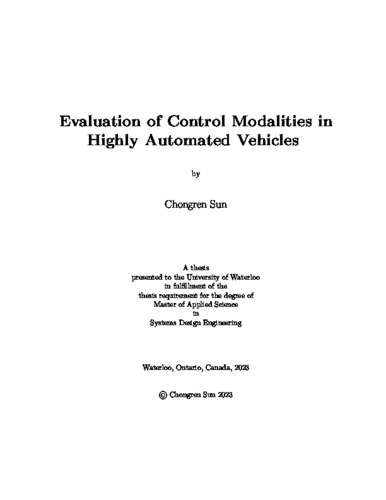| dc.contributor.author | Sun, Chongren | |
| dc.date.accessioned | 2023-09-01 19:06:06 (GMT) | |
| dc.date.available | 2023-09-01 19:06:06 (GMT) | |
| dc.date.issued | 2023-09-01 | |
| dc.date.submitted | 2023-08-22 | |
| dc.identifier.uri | http://hdl.handle.net/10012/19831 | |
| dc.description.abstract | Autonomous driving vehicles are classified by researchers into six levels, ranging from 0 to 5. The level of autonomy increases with the level number, with vehicles at levels 4 or 5 possessing the capability for full self-driving without human intervention. In high-level autonomous driving, user control model can be adapted to meet user demands since drivers are not required to focus on the road. Thus, measuring the metrics and trade-offs of control modalities under this new driving paradigm is crucial. This study proposes an evaluation framework for control modalities in level 4 and 5 autonomous vehicles, particularly in distraction scenarios.
The research comprises two parts. The first part is a user requirement study. A questionnaire, which surveyed 150 participants, investigated potential control modalities and features in self-driving vehicles. Following this, a user study that incorporated both between-participant and within-participant designs was conducted. The between-participant design aimed to compare three control modalities: physical buttons, voice, and hand gesture. Additionally, a within-participant design tested each participant's performance while being distracted. The study collected both objective and subjective data, including user error rates, physiological data, the NASA TLX rating scale, and interview feedback.
The evaluation revealed that the hand gesture control modality yielded the lowest user performance without distractions and was least affected by distractions compared to the other models. Users who engaged with the voice control modality experienced a lower error rate and workload but were also more susceptible to distractions. | en |
| dc.language.iso | en | en |
| dc.publisher | University of Waterloo | en |
| dc.subject | Self-driving | en |
| dc.subject | Human-computer Interaction | en |
| dc.subject | Control Modalities | en |
| dc.subject | Distraction | en |
| dc.subject | Virtual Reality | en |
| dc.subject | Driving Simulation | en |
| dc.title | Evaluation of Control Modalities in Highly Automated Vehicles | en |
| dc.type | Master Thesis | en |
| dc.pending | false | |
| uws-etd.degree.department | Systems Design Engineering | en |
| uws-etd.degree.discipline | System Design Engineering | en |
| uws-etd.degree.grantor | University of Waterloo | en |
| uws-etd.degree | Master of Applied Science | en |
| uws-etd.embargo.terms | 0 | en |
| uws.contributor.advisor | Samuel, Siby | |
| uws.contributor.affiliation1 | Faculty of Engineering | en |
| uws.published.city | Waterloo | en |
| uws.published.country | Canada | en |
| uws.published.province | Ontario | en |
| uws.typeOfResource | Text | en |
| uws.peerReviewStatus | Unreviewed | en |
| uws.scholarLevel | Graduate | en |

